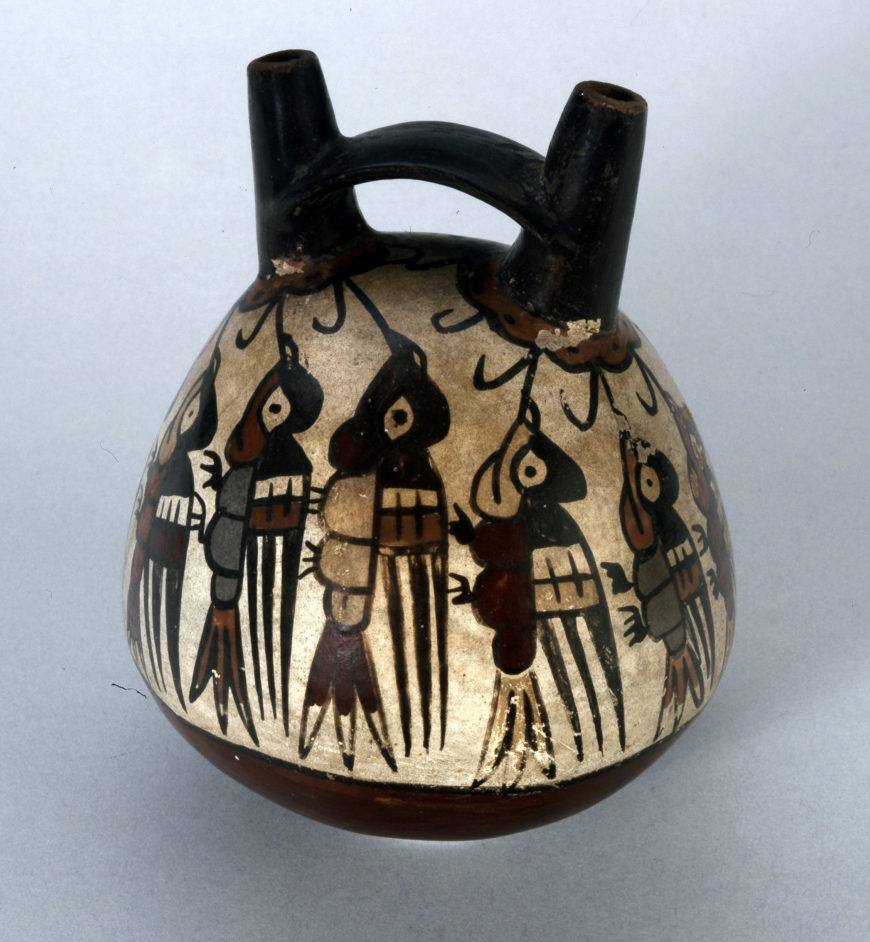
Double spout and bridge vessel with hummingbirds, 100 B.C.E.–600 C.E., Nasca, painted pottery, 10 cm in diameter (© Trustees of the British Museum)
The double spout and bridge vessel is one of the oldest ceramic forms known in Nasca art. This example is decorated with several hummingbirds flying around two flowers at the base of the spouts, a motif which is characteristic of the early phases of the Nasca cultural sequence. In some areas of Peru today, hummingbirds are considered to be the intermediaries or even manifestations of the mountain gods.
The innovative techniques and aesthetic qualities of Nasca polychrome ceramics make them unique in the Andean region. They were most commonly made by coiling. Slip was then applied, the vessel fired and burnished to a characteristic glossy finish. The slip was made from different mineral pigments such as manganese (black) and iron oxide (red). This represents an innovation on previous resin painting, and helped ensure the preservation of the vivid painted motifs.
The most common shapes of Nasca polychrome ceramics are bowls, dishes, vases and vessels with one or two spouts and bridge. They are reserved for the élite and are used as grave offerings.
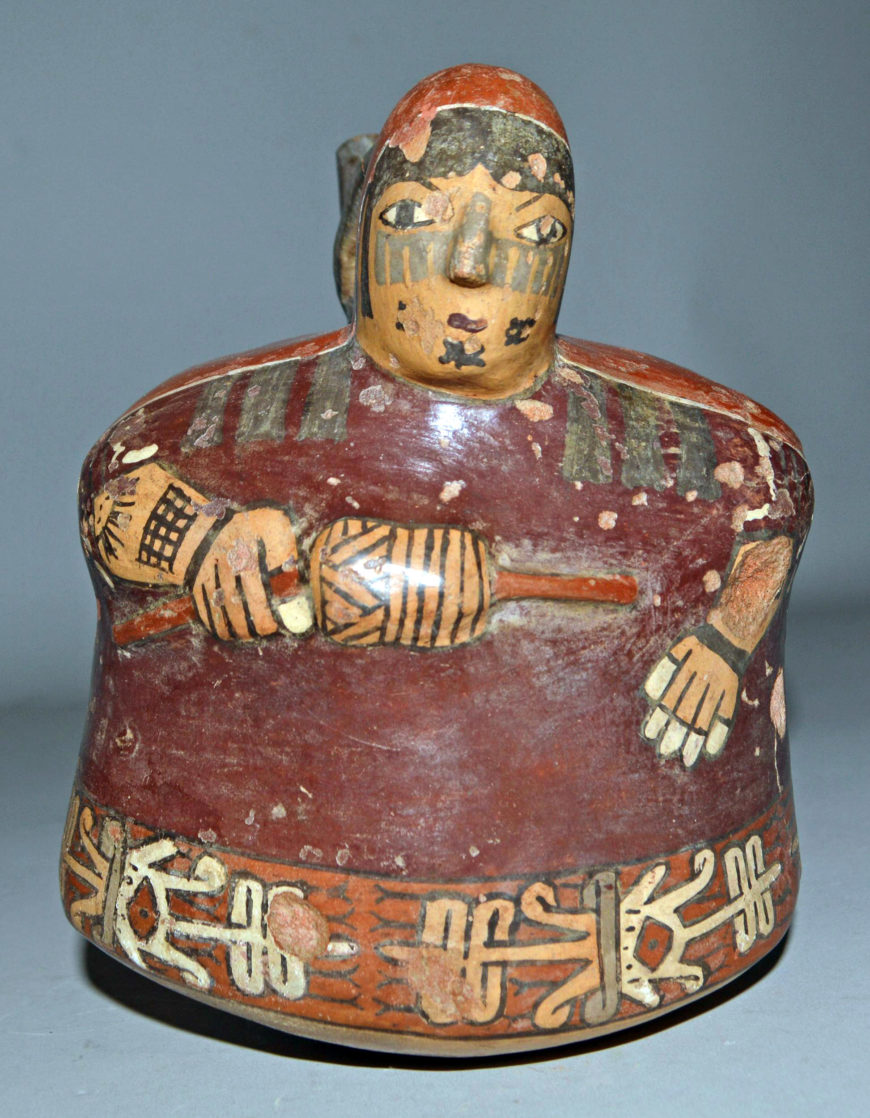
Spout and bridge vessel in the shape of a woman, 100 B.C.E.–600 C.E., Nasca, painted pottery, 16.5 x 13 cm (© Trustees of the British Museum)
Human figures
The vessel represents a standing woman holding an instrument, possibly a spindle wrapped in a cloth. She is wearing facial and body paint with intricate motifs. A repeating motif circles the bottom of the vessel.
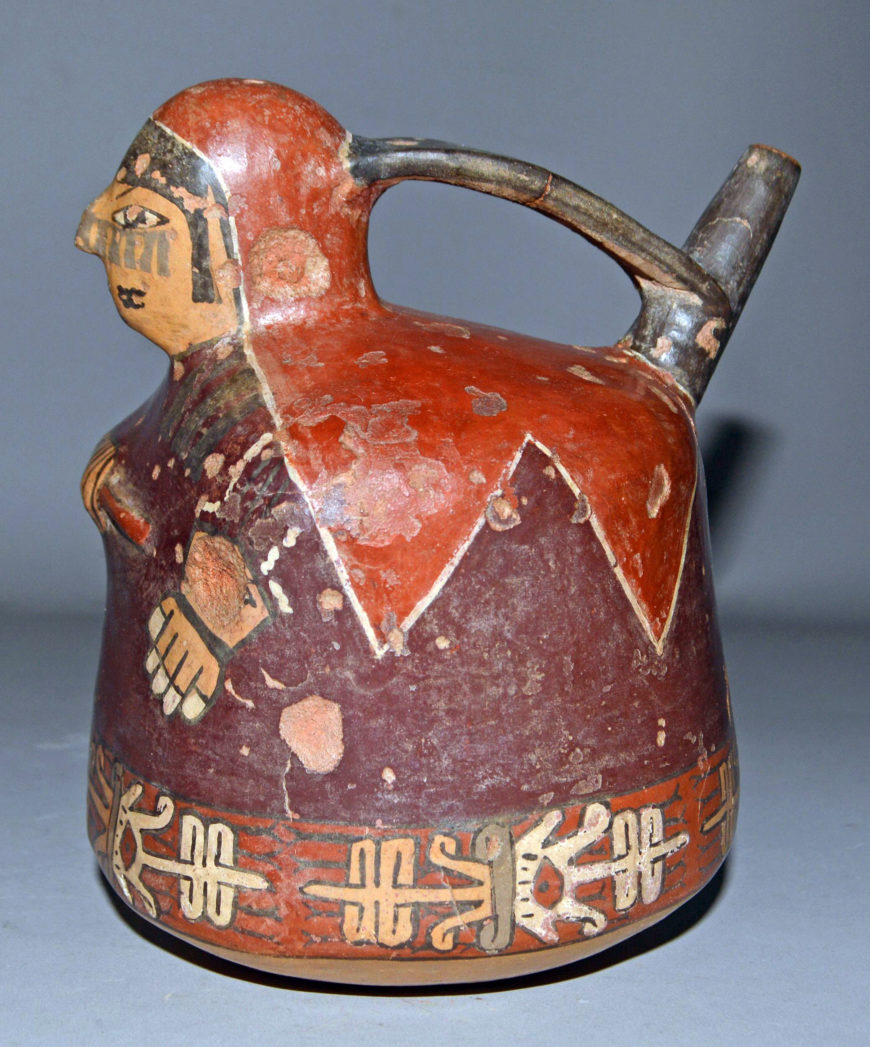
Spout and bridge vessel in the shape of a woman, 100 B.C.E.–600 C.E., Nasca, painted pottery, 16.5 x 13 cm (© Trustees of the British Museum)
Human figures, both male and female, are either painted around Nasca vessels or modeled into a head or full figure. The figures depicted are associated with: subsistence activities, where they hold agricultural products and tools used in farming, fishing or hunting; with war scenes, where they hold weapons such as darts, maces, spears and trophy heads, and with music, where they play instruments such as pan pipes, drums, and rattles.
Effigy vessels representing human figures appeared in the first century C.E.. There are also vessels modeled into animals (such as birds, dogs or snakes) or edible plants (maize or fruits).
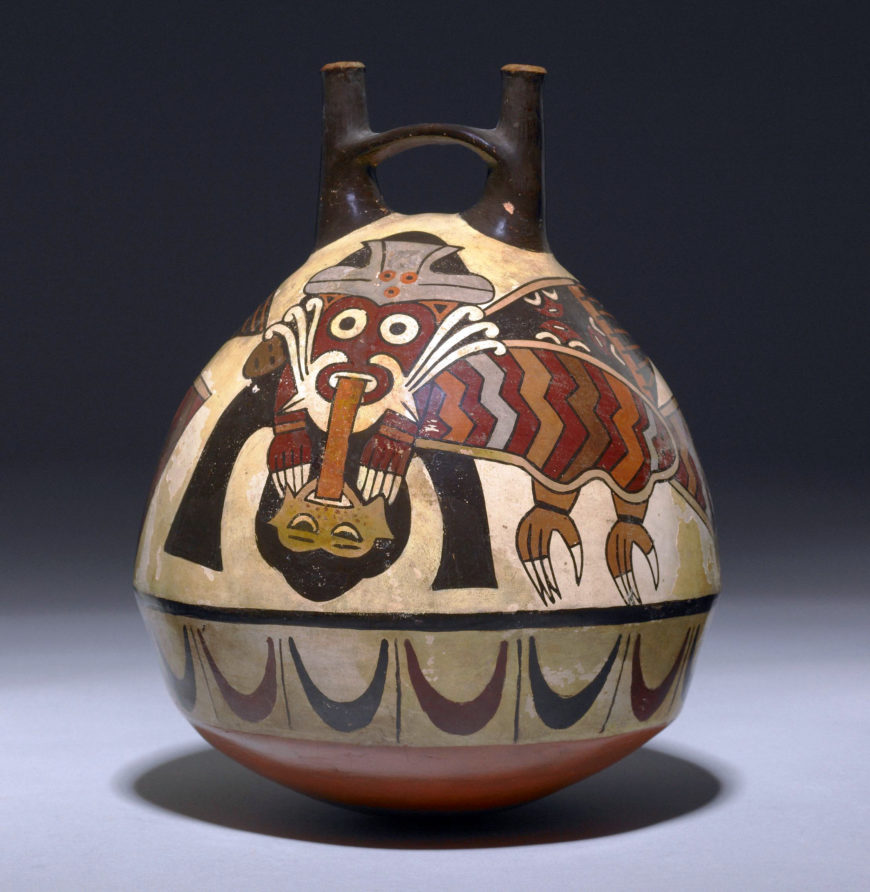
Double spout and bridge pottery vessel with a bird deity, 100 B.C.E.–600 C.E., Nasca, painted pottery, 23.5 cm in diameter (© Trustees of the British Museum)
A bird deity
This globular jar depicts a fantastic bird in flight with a human face, adorned with a mouth mask and a diadem. The bird holds a human trophy head. Ritual beheading was a common practice in the Andes and scenes of decapitation can be seen painted on Nasca vessels. Not all birds depicted in Nasca art can be identified to a particular species. Some representations are quite naturalistic, while others combine fantastic and anthropomorphic elements.
Certain birds are still revered in the Andean region today. The people of the modern town of Nasca believe that the condor and other birds, such as the pelican and the heron, are manifestations of the mountain gods. To catch sight of one of these birds means that rain will fall in the mountains.
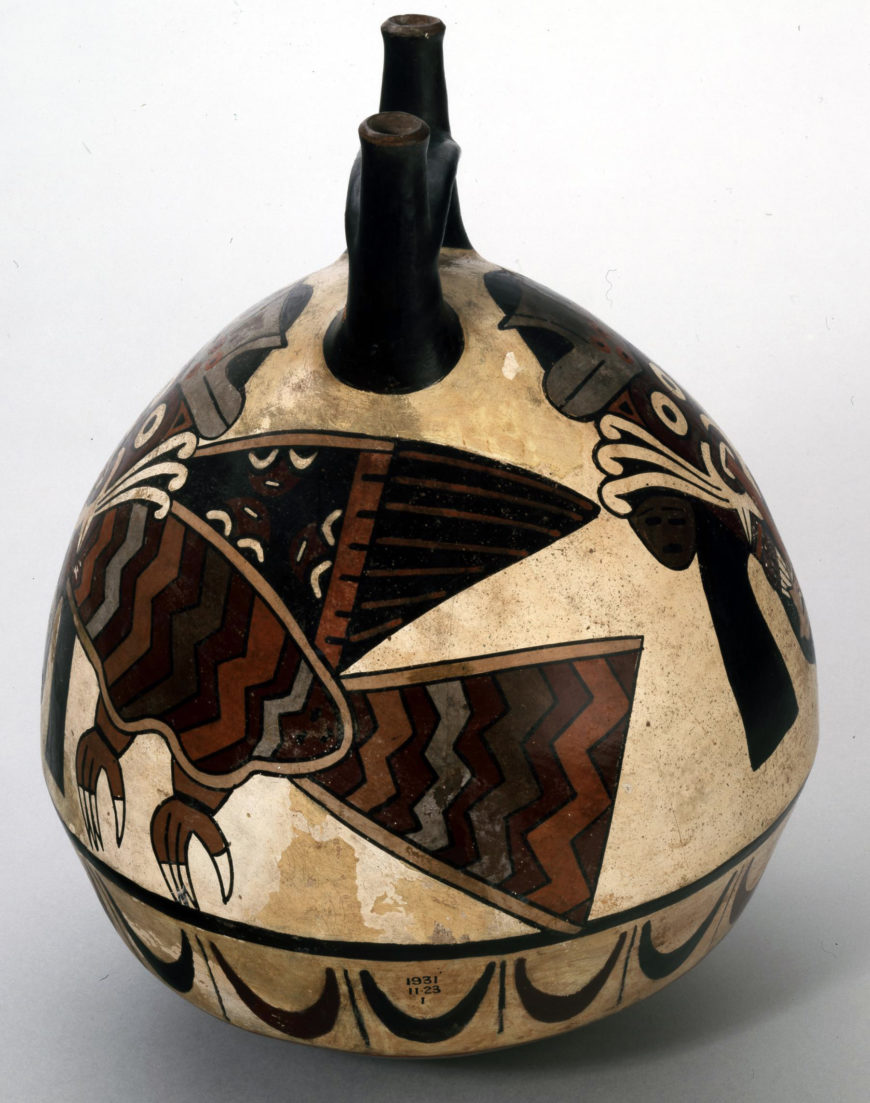
Double spout and bridge pottery vessel with a bird deity, 100 B.C.E.–600 C.E., Nasca, painted pottery, 23.5 cm in diameter (© Trustees of the British Museum)
The technique and range of colors used on this large vessel mark the peak of Nasca achievements. The number of colors used by Nasca artists is larger than that used by any other culture in the Americas before European contact.
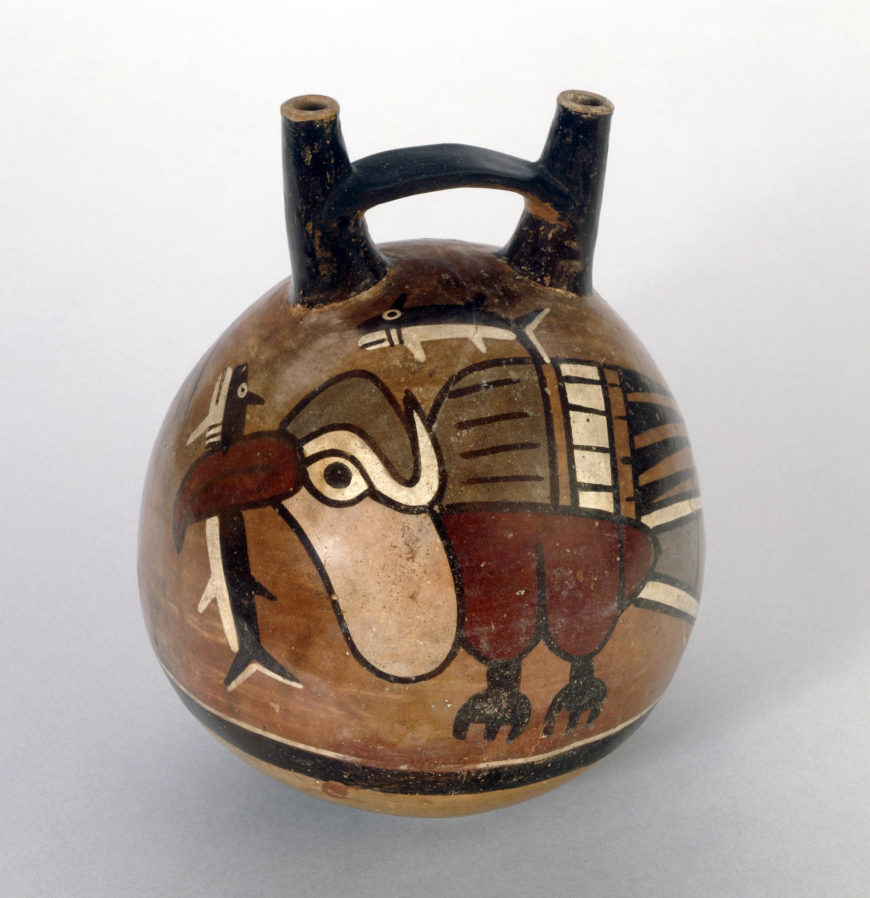
Double spout and bridge vessel with pelican and fish, 100 B.C.E.–600 C.E., Nasca, painted pottery, 14 cm in diameter (© Trustees of the British Museum)
Manifestations of the mountain gods
The body of the vessel is painted with a pelican holding a fish in its beak. Several species of birds, both marine and terrestrial, are represented on Nasca ceramics; although the depictions are quite naturalistic, it is not always easy to determine their species.
Birds played an important role for Nasca people and bird feathers were used as ornaments for high ranking people and textiles. A sixteenth-century chronicle written by a Spanish friar describes islands off the south coast where large quantities of bird droppings were collected and used as fertilizer.
Certain birds are still revered in the Andean region today. The people of the modern town of Nasca believe that the pelican and other birds, such as the condor and the heron, are manifestations of the mountain gods. To catch sight of one of these birds means that rain will fall in the mountains. Hummingbirds are considered to be the intermediaries of the mountain gods, or even a manifestation of them.
© Trustees of the British Museum

